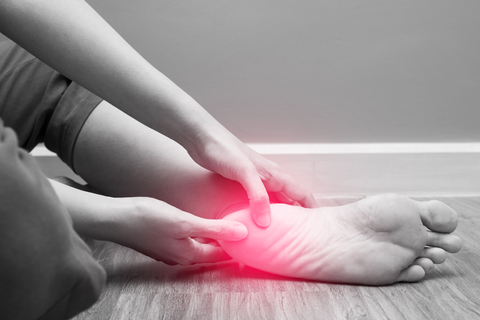What is Plantar Fasciitis?
Plantar fasciitis is a common condition that causes pain and discomfort in the heel and arch of the foot. It occurs when the plantar fascia (also called the plantar aponeurosis), a thick band of tissue that connects the heel bone to the toes, becomes irritated and on rare occasions, inflamed.

Also, its important to know that symptoms of ‘plantar fasciitis’ is caused by chronically tight muscles of the calf and foot that refer pain into the heel and sole of foot. Or irritation of any of muscle tendons that insert into the heel.
Signs and Symptoms
The most common symptom of plantar fasciitis (PF) is pain in the heel and arch of the foot, especially when taking the first steps in the morning or after a period of inactivity. In the the early stages, it can hurt when starting exercise, but this wears off when warmed up. If ignored, the condition can get worse until its becomes a permanent sharp pain whenever weight-bearing. Taking the weight off your feet is the only way to resolve the pain.

Causes of Plantar Fasciitis
Plantar fasciitis is classed as an overuse injury. Overuse is one of the most common causes of PF and occurs when the plantar fascia is subjected to repetitive stress without adequate rest and recovery time. When the muscles of the calves and feet are not conditioned enough to support marathon training, for example, the plantar fascia therefore has to compensate and is irritated when exposed to the excessive load.
Increased risk factors are previous foot or ankle injury, obesity, pregnancy and diabetes. Biomechanical issues, such as flat feet or high arches, or muscle strength imbalances causes abnormal distribution of weight on the feet, lead to stress on the plantar fascia. As stated above, tight calf muscles can also cause the same symptoms. Alternative causes of the pain could be stress fractures, infections, ankle joint arthritis or bursitis.
A good stretching routine for the lower legs will help prevent and resolve minor conditions. We produced a stretch demonstration here.
What is the Best Treatment for Plantar Fasciitis?
As with any overuse injury, treatment for PF typically involves rest and modification of activity. Ice and over-the-counter pain medication can help to relieve the pain in the short term. It’s important to note that early diagnosis and treatment can easily prevent the condition from getting worse.
A sensible progressive training and exercise programme can also help prevent the onset of this condition. A good article on preventing PF for runners is here. Maintaining a healthy weight through regular exercise and a balanced diet can also reduce the risk of developing plantar fasciitis.
A sports therapy assessment at our clinic can assess the pain and diagnosis the problem. We would normally use a combination of treatments, from cutting-edge laser therapy to hands-on manual therapy techniques, rehab exercises and sports massage to get you back to your favourite activities without discomfort and pain. You can book a Sports Therapy appointment (for pain treatment) here.
 Enter your name and email and request our free ebook: 7 Habits of Highly Effective Runners
Enter your name and email and request our free ebook: 7 Habits of Highly Effective Runners